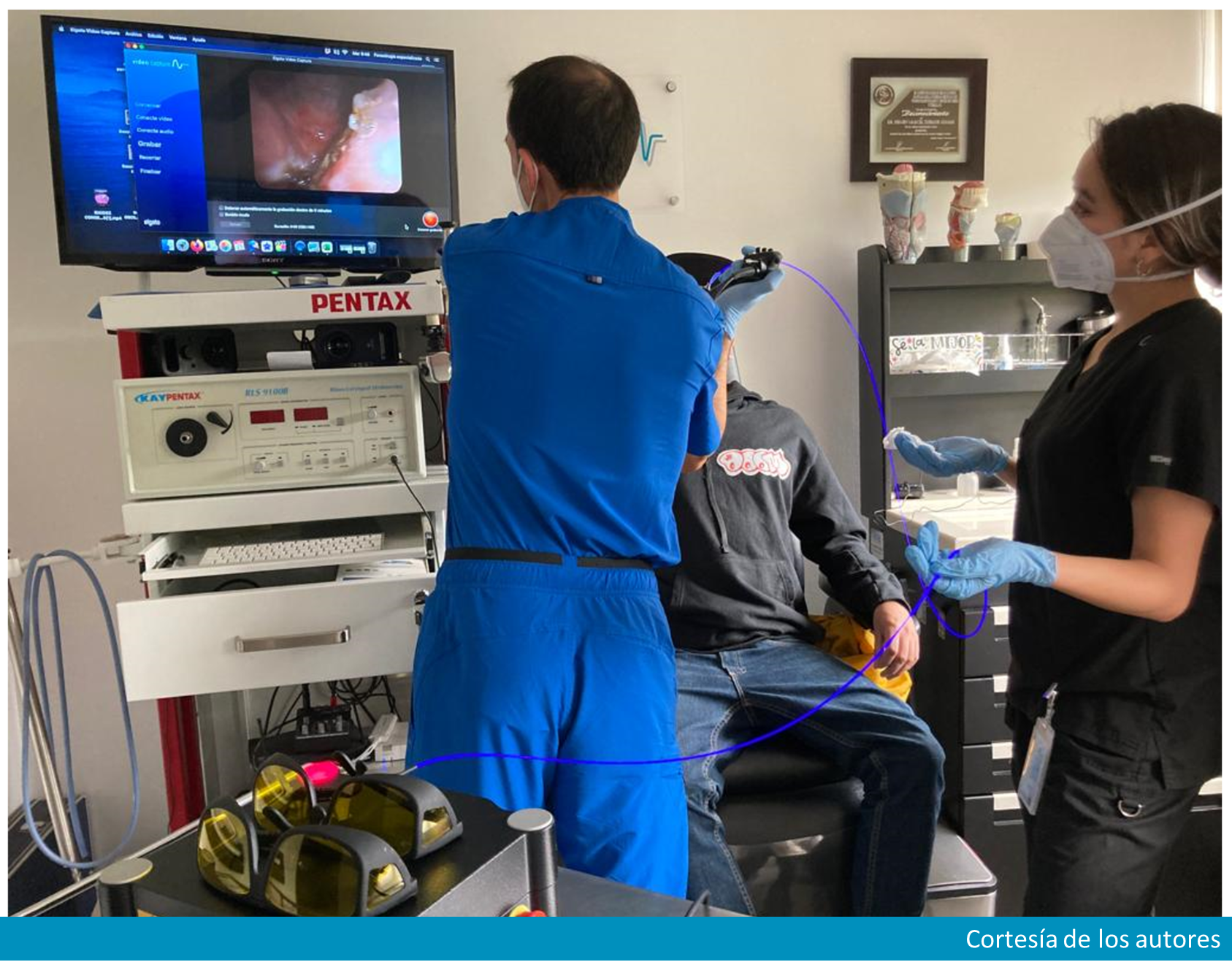In-office Laryngeal Procedures: a Modern Perspective for Vocal Fold Interventions
Procedimientos laríngeos en el consultorio: una perspectiva moderna para las intervenciones de cuerdas vocales

This work is licensed under a Creative Commons Attribution-NonCommercial-NoDerivatives 4.0 International License.
Show authors biography
Introduction. The purpose of this article is to discuss in-office laryngeal procedures as an alternative to surgical intervention under general anesthesia. In-office procedures have become more common due to technological advancements. As a result, these approaches are less invasive and more patient-friendly, with increased pain tolerance and reduced procedure time and cost.
Methods. We conducted a thematic analysis of published reports regarding the best known and performed in-office laryngeal interventions. Three questions guided our analysis: What laryngological procedures can be performed in the office setting? What are the advantages of in-office laryngology procedures compared to operating room surgical procedures? Why aren't more in-office procedures performed in some Latin American countries?
Discussion. Despite being performed more frequently, there is still controversy whether in-office procedures should be performed as often due to the risk of complications. Furthermore, procedures that are done in the office setting are more popular in some countries than in others, even though their benefit has been well demonstrated. This article describes various in-office procedures, including biopsy, vocal fold injections, and laser surgery. We also discuss what factors might contribute to having office-procedures being performed more frequently in some countries than others.
Conclusion. Awake interventions offer numerous benefits, including shorter procedure time, reduced costs, and lower patient morbidity. These advantages have significantly transformed the treatment of laryngeal diseases in modern laryngology practice in a global manner.
Article visits 381 | PDF visits 151
- Koufman JA. Introduction to office-based surgery in laryngology. vol. 15. Wolters Kluwer Health | Lippincott Williams & Wilkins; 2007. doi: https://doi.org/10.1097/MOO.0b013e3282f23088
- Marinone Lares SG, Allen JE. Safety of in-office laryngology procedures. Curr Opin Otolaryngol Head Neck Surg. 2019;27:433–8. doi: https://doi.org/10.1097/MOO.0000000000000585
- Bensoussan Y, Anderson J. In-office laryngeal procedures (IOLP) in Canada: Current safety practices and procedural care. Journal of Otolaryngology - Head and Neck Surgery. 2018;47. doi: https://doi.org/10.1186/s40463-018-0270-2
- Tibbetts KM, Simpson CB. Office-Based 532-Nanometer Pulsed Potassium-Titanyl-Phosphate Laser Procedures in Laryngology. Otolaryngol Clin North Am. 2019;52:537–57. doi: https://doi.org/10.1016/j.otc.2019.02.011
- Madden LL, Ward J, Ward A, Young VVN, Smith LJ, Lott DG, et al. A cardiovascular prescreening protocol for unmonitored in-office laryngology procedures. Laryngoscope. 2017;127:1845–9. doi: https://doi.org/10.1002/lary.26481
- Yung KC, Courey MS. The Effect of office-based flexible endoscopic surgery on hemodynamic stability. Laryngoscope. 2010;120:2231–6. doi: https://doi.org/10.1002/lary.21135
- Wellenstein DJ, Schutte HW, Takes RP, Honings J, Marres HAM, Burns JA, et al. Office-Based Procedures for the Diagnosis and Treatment of Laryngeal Pathology. Journal of Voice. 2018;32:502–13. doi: https://doi.org/10.1016/j.jvoice.2017.07.018
- Anderson J, Bensoussan Y, Townsley R, Kell E. In-Office Endoscopic Laryngeal Laser Procedures: A Patient Safety Initiative. Otolaryngology - Head and Neck Surgery (United States). 2018;159:136–42. doi: https://doi.org/10.1177/0194599818774511
- Zubiaur-Gomar FM, García-Palmer R, De la Garza-Hesles H. Uso de láser KTP para el tratamiento fonomicroquirúrgico del cáncer glótico y otras lesiones benignas de la laringe: análisis comparativo con el láser de CO2. An Orl Mex. 2012;57:189–191955. Available from: https://tinyurl.com/yku8trx9
- Ossoff RH, Coleman JA, Courey MS, Duncavage JA, Werkhaven JA, Reinisch L. Clinical Applications of Lasers in Otolaryngology-Head and Neck Surgery. 1994;15(3):217-248. doi: https://doi.org/10.1002/lsm.1900150302
- Yan Y, Olszewski AE, Hoffman MR, Zhuang P, Ford CN, Dailey SH, et al. Use of Lasers in Laryngeal Surgery. Journal of Voice. 2010;24:102–9. doi: https://doi.org/10.1016/j.jvoice.2008.09.006
- Wellenstein DJ, Honings J, Schimberg AS, Schutte HW, Herruer JM, van den Hoogen FJA, et al. Office-based CO2 laser surgery for benign and premalignant laryngeal lesions. Laryngoscope. 2020;130:1503–7. doi: https://doi.org/10.1002/lary.28278
- Zeitels SM, Burns JA. Office-based laryngeal laser surgery with local anesthesia. Curr Opin Otolaryngol Head Neck Surg [Internet]. 2007;15(3):141-7. doi: https://doi.org/10.1097/MOO.0b013e3281574582
- Hantzakos AG, Khan M. Office Laser Laryngology: A Paradigm Shift. Ear Nose Throat J. 2021;100:59S-62S. doi: https://doi.org/10.1177/0145561320930648
- Shoffel-Havakuk H, Sadoughi B, Sulica L, Johns MM. In-office procedures for the treatment of benign vocal fold lesions in the awake patient: A contemporary review. Laryngoscope. 2019;129:2131–8. doi: https://doi.org/10.1002/lary.27731
- Filauro M, Vallin A, Fragale M, Sampieri C, Guastini L, Mora F, et al. Office-based procedures in laryngology procedure ambulatoriali in laringologia. Acta Otorhinolaryngologica Italica. 2021;41:243–7. doi: https://doi.org/10.14639/0392-100X-N0935
- Yang J, Xie Z, Seyler BC. Comparing KTP and CO2 laser excision for recurrent respiratory papillomatosis: A systematic review. Laryngoscope Investig Otolaryngol. 2022;7:970–81. doi: https://doi.org/10.1002/lio2.871
- Remacle M, Arens C, Eldin MB, Campos G, Estomba CC, Dulguerov P, et al. Laser-assisted surgery of the upper aero-digestive tract: a clarification of nomenclature. A consensus statement of the European Laryngological Society. European Archives of Oto-Rhino-Laryngology. 2017;274:3723–7. doi: https://doi.org/10.1007/s00405-017-4708-3
- Del Signore AG, Shah RN, Gupta N, Altman KW, Woo P. Complications and Failures of Office-Based Endoscopic Angiolytic Laser Surgery Treatment. Journal of Voice. 2016;30:744–50. doi: https://doi.org/10.1016/j.jvoice.2015.08.022
- Hu HC, Lin SY, Hung YT, Chang SY. Feasibility and associated limitations of office-based laryngeal surgery using carbon dioxide lasers. JAMA Otolaryngol Head Neck Surg. 2017;143:485–91. doi: https://doi.org/10.1001/jamaoto.2016.4129
- Reich DL. Monitoring in anesthesia and perioperative care. Cambridge: Cambridge University Press; 2011.
- Rees CJ, Halum SL, Wijewickrama RC, Koufman JA, Postma GN. Patient tolerance of in-office pulsed dye laser treatments to the upper aerodigestive tract. Otolaryngology - Head and Neck Surgery. 2006;134:1023–7. doi: https://doi.org/10.1016/j.otohns.2006.01.019
- Rees CJ, Postma GN, Koufman JA. Cost Savings of Unsedated Office-Based Laser Surgery for Laryngeal Papillomas. Ann Otol Rhinol Laryngol. 2007 Jan;116(1):45-8. doi: https://doi.org/10.1177/000348940711600108
- Chen S, Connors J, Zhang Y, Wang B, Vieira D, Shapira-Galitz Y, et al. Recurrent Respiratory Papillomatosis Office versus Operating Room: Systematic Review and Meta-Analysis. Annals of Otology, Rhinology and Laryngology. 2021;130:234–44. doi: https://doi.org/10.1177/0003489420949586
- Naidu H, Noordzij JP, Samim A, Jalisi S, Grillone GA. Comparison of efficacy, safety, and cost-effectiveness of in-office cup forcep biopsies versus operating room biopsies for laryngopharyngeal tumors. Journal of Voice. 2012;26:604–6. doi: https://doi.org/10.1016/j.jvoice.2011.10.003
- Andrade Filho PA, Carrau RL, Buckmire RA. Safety and cost-effectiveness of intra-office flexible videolaryngoscopy with transoral vocal fold injection in dysphagic patients. American Journal of Otolaryngology - Head and Neck Medicine and Surgery. 2006;27:319–22. doi: https://doi.org/10.1016/j.amjoto.2006.01.009



